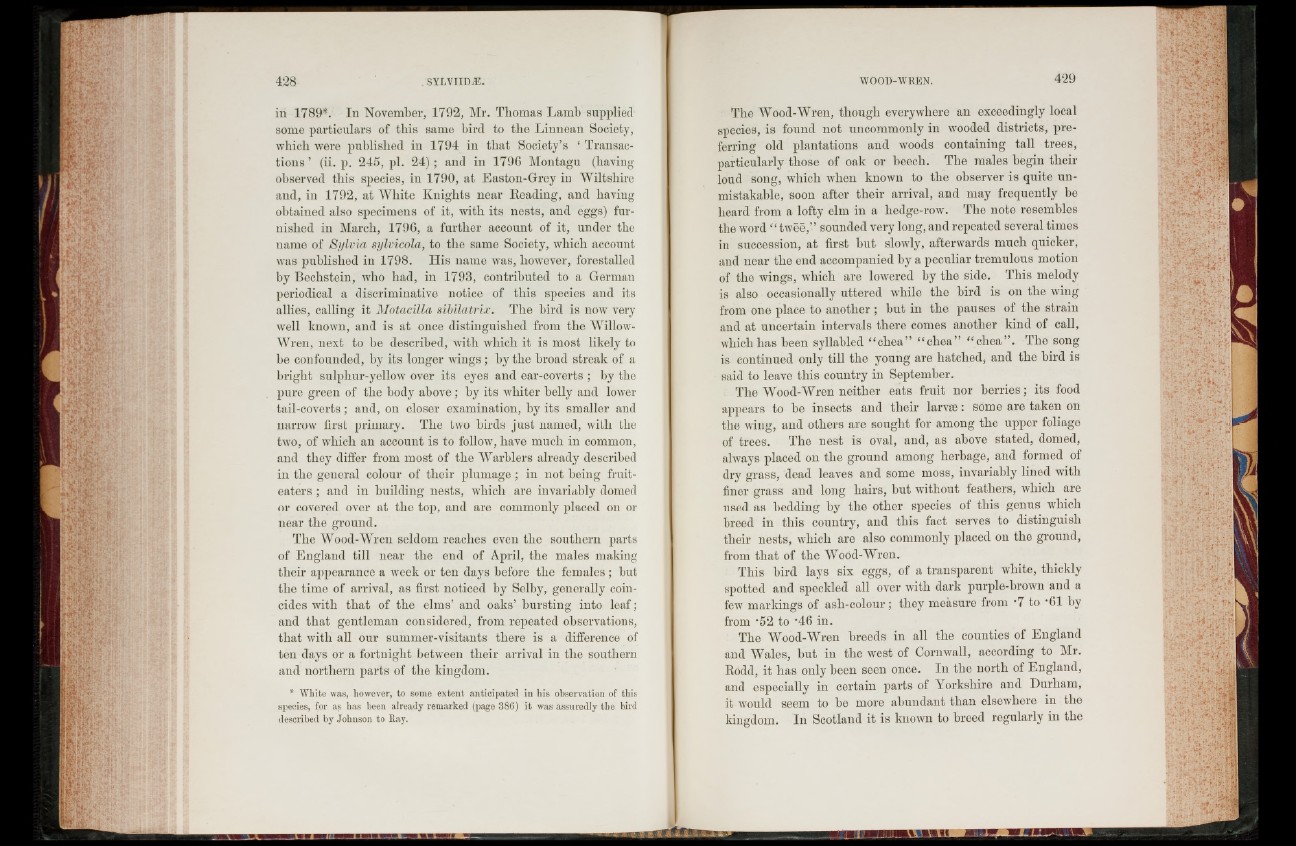
in 1789*. In November, 1792, Mr. Thomas Lamb supplied
some particulars of this same bird to the Linnean Society,
which were published in 1794 in that Society’s * Transactions
’ (ii. p. 245, pi. 24); and in 1796 Montagu (having
observed this species, in 1790, at Easton-Grey in Wiltshire
and, in 1792, at White Knights near Reading, and having
obtained also specimens of it, with its nests, and eggs) furnished
in March, 1796, a further account of it, under the
name of Sylvia sylvicola, to the same Society, which account,
was published in 1798. His name was, however, forestalled
by Bechstein, who had, in 1793, contributed to a German
periodical a discriminative notice of this species and its
allies, calling it Motacilla sibilatrix. The bird is now very
well known, and is at once distinguished from the Willow-
Wren, next to be described, with which it is most likely to
be confounded, by its longer wings; by the broad streak of a
bright sulphur-yellow over its eyes and ear-coverts ; by the
pure green of the body above ; by its whiter belly and lower
tail-coverts; and, on closer examination, by its smaller and
narrow first primary. The two birds just named, with the
twro, of which an account is to follow, have much in common,
and they differ from most of the Warblers already described
in the general colour of their plumage; in not being fruit-
eaters ; and in building nests, which are invariably domed
or covered over at the top, and are commonly placed on or
near the ground.
The Wood-Wren seldom reaches even the southern parts
of England till near the end of April, the males making
their appearance a week or ten days before the females; but
the time of arrival, as first noticed by Selby, generally coincides
with that of the elms’ and oaks’ bursting into leaf;
and that gentleman considered, from repeated observations,
that with all our summer-visitants there is a difference of
ten days or a fortnight between their arrival in the southern
and northern parts of the kingdom.
* White was, however, to some extent anticipated in his observation of this
species, for as has been already remarked (page 386) it was assuredly the bird
described by Johnson to Hay.
The Wood-Wren, though everywhere an exceedingly local
species, is found not uncommonly in wooded districts, preferring
old plantations and woods containing tall trees,
particularly those of oak or beech. The males begin their
loud song, which when known to the observer is quite unmistakable,
soon after their arrival, and may frequently be
heard from a lofty elm in a liedge-row. The note resembles
the word “ twee,” sounded very long, and repeated several times
in succession, at first but slowly, afterwards much quicker,
and near the end accompanied by a peculiar tremulous motion
of the wings, which are lowered by the side. This melody
is also occasionally uttered while the bird is on the wing
from one place to another ; but in the pauses of the strain
and at uncertain intervals there comes another kind of call,
which has been syllabled “ chea” “ chea” “ chea” . The song
is continued only till the young are hatched, and the bird is
said to leave this country in September.
The Wood-Wren neither eats fruit nor berries; its food
appears to be insects and their larvae: some are taken on
the wing, and others are sought for among the upper foliage
of trees. The nest is oval, and, as above stated, domed,
always placed on the ground among herbage, and formed of
dry grass, dead leaves and some moss, invariably lined with
finer grass and long hairs, but without feathers, which are
used as bedding by the other species of this genus which
breed in this country, and this fact serves to distinguish
their nests, which are also commonly placed on the ground,
from that of the Wood-Wren.
This bird lays six eggs, of a transparent white, thickly
spotted and speckled all over with dark purple-brown and a
few markings of ash-colour; they measure from -7 to -61 by
from '52 to '46 in.
The Wood-Wren breeds in all the counties of England
and Wales, but in the west of Cornwall, according to Mr.
Rodd, it has only been seen once. In the north of England,
and especially in certain parts of Yorkshire and Durham,
it would seem to be more abundant than elsewhere in the
kingdom. In Scotland it is known to breed regularly in the